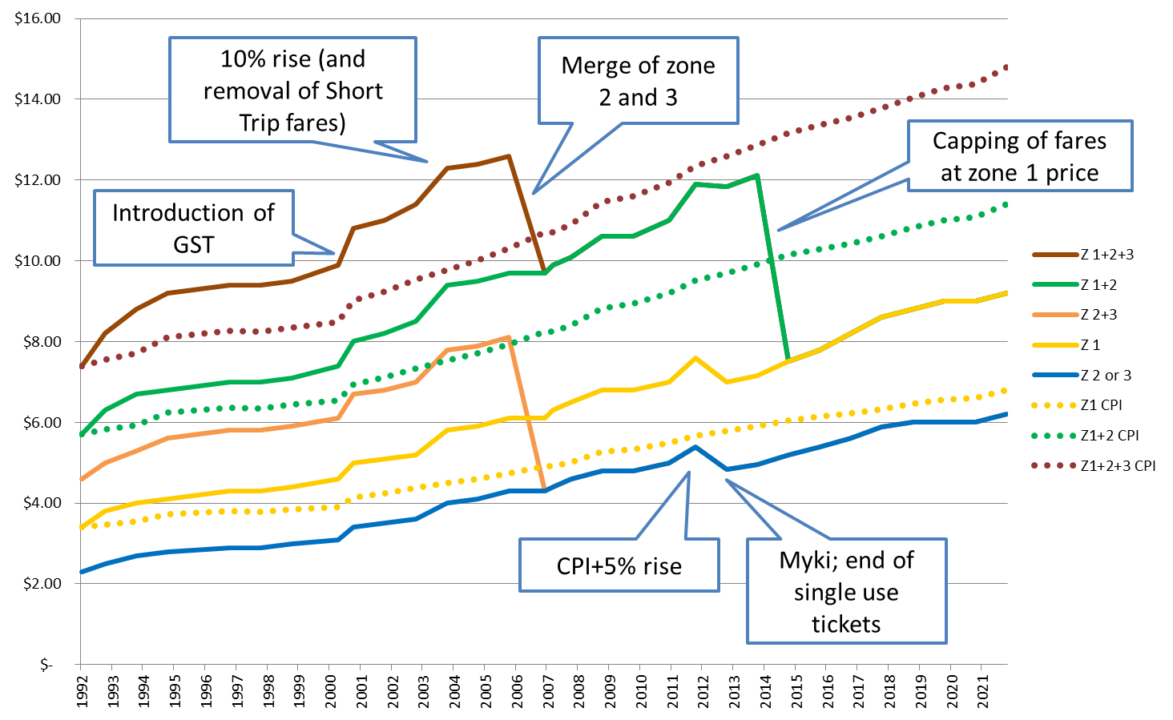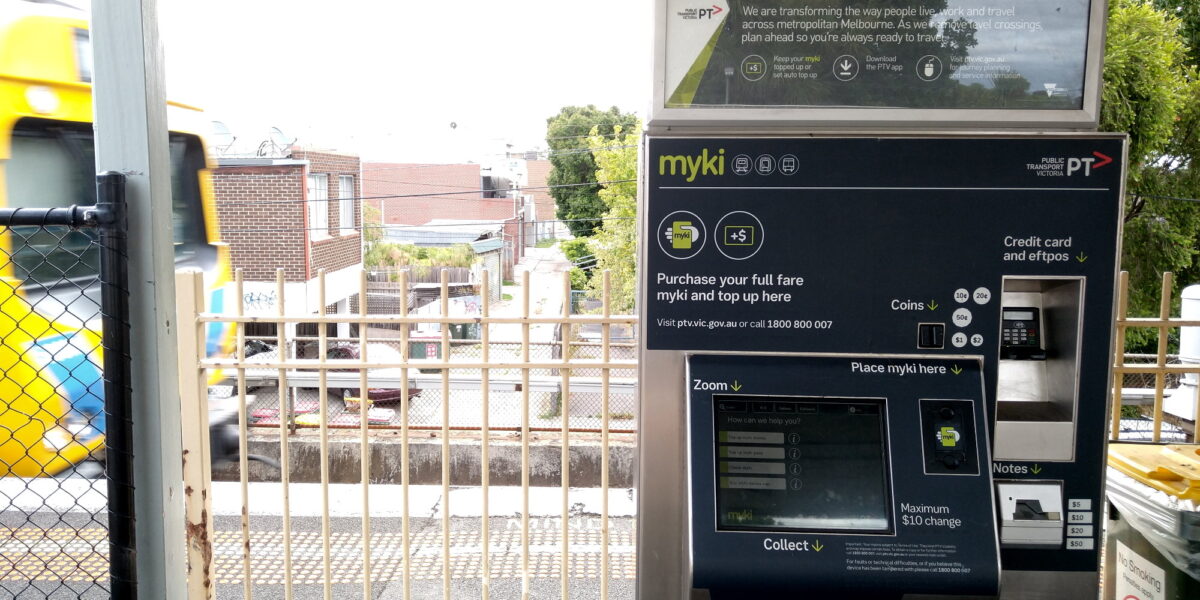A fare rise took effect from 1st January. It’s usually more-or-less in line with the annual CPI to September the previous year – this time 2.3% against CPI of 2.9%.
CPI was so low in 2020 that they waived the increase in January 2021, but most other years they’ve done it.
I thought it might be interesting to track Daily metropolitan fares over time. Here they for the last 30 years:

Some observations:
Edit 6/1/2022: Following some feedback, I’ve added dotted lines showing three of the prices since 1992, if they had strictly followed CPI.
As you can see from the Zone 1 price (yellow lines), fares rose well above CPI under both sides of government over the 30 years. The daily Zone 1 fare is now $9.60. It would have been $6.80 if it had followed CPI.
Two and three zone fare cuts in 2007 and 2015 have brought those fares back under CPI.
Over time the 5 different prices for different zones (6 combinations – zones 2 and 3 individually were the same price) have merged down to just 2.
Zone 1+2+3 daily fares peaked in 2006 at $12.60, then dropped in 2007 (with the merge of zone 2 and 3), before climbing again to $12.12… then dropped again in 2015 with the capping of fares at zone 1 rates. This also reduced prices for zone 1+2 trips.
2000 saw a bigger than usual rise thanks to the introduction of GST.
2004 saw another big rise when the then-Labor government brought in a rise of almost 10%.
The 2004 rise also saw Short Trip tickets removed, meaning some trips jumped from $1.80 to $3.00. Short trip tickets were kept for CBD travel (as the “City Saver” ticket) until that too was removed in 2012 when Myki took over. CBD tram trips were then made free in 2015.
There was another upwards bump in 2012, thanks to a policy set by Labor when in government, and implemented by the Coalition, of CPI+5% rises two years in a row. This was hidden in 2013 because by then everyone had switched to Myki – effectively making all fares subject to the 5 x Daily (or 10 x 2 hour) discount.
In late 2012, the Myki rollout was completed, and Metcard was switched off.
I don’t know for sure, but I wouldn’t be surprised if the CPI+5% rise was planned knowing that most people would switch to Myki’s cheaper fares. Back in 2010 when Labor formulated the policy, Myki was intended to have a single use ticket. This option was removed by the Coalition, so it ended up being that everyone switched to Myki.
You might notice that the Zone 1+2 fare barely dropped with the shift from Metcards to Myki fares. Under Myki a multi-zone fare is the sum of the individual zone fares. This wasn’t the case under Metcard – the final Z1+2 daily fare in 2012 was $11.90 compared to Z1 $7.60 and Z2 $5.40.
The Coalition introduced its own CPI+2.5% rises for 2015-2018, which were then in turn implemented by Labor.
For people who travel just in Zone 1, all these rises mean they’ve seen steady increases, without the benefit of zone removal/merger or fare capping.
The daily fare at $9.20 in 2022 is exactly 100% above what it was in 2000, against inflation over that time of about 70%.
The $9.20 fare is also the same as a Zone 1+2+3 fare was back in 1995.
The merging of zones and capping of prices means we now have a mostly flat fare system… which is good for those travelling longer distances… but bad for those travelling short distances.
It’s very messy when you travel out of metropolitan Melbourne – there’s a big jump in fare prices – so much so that in the past some people have gamed the system by trying to momentarily hop off the train in Zone 2 and touching off, then on again.
Room for reform?
There’s been a lot of fiddling over the years – removal of zones, capping, over-CPI rises. Will we see genuine fare reform? For a while in 2021 there was an off-peak discount, which might have helped encourage patronage at those times, but was ended in August before things started to open back up.
While the government is looking at a change of ticket system operator, I suspect actually changing the fares or zones isn’t near the top of the agenda at the moment.
The principles of the zones and timed fares are actually pretty sound, and easy to understand, but some adjustments such as moving to weekly capping (instead of pre-loaded Passes) and fixing pricing anomalies would be very welcome.
- 2018: A look at the price rise that year – noting that some Sydney short trips were half the cost of Melbourne
- 2021: A more recent post on overall fare revenue
- The PTUA view is they should replace the 7-Day Pass with a more competitively-priced weekly cap, and bring back the off-peak discount permanently


7 replies on “Fares 1992-2022”
All the information on the internet can not beat the clear and concise information about country zones and Myki charges in the brochure I picked up today at Bacchus Marsh Station. There was also heaps of small timetables for all country train lines. The net is so good but so is the written word for fast clarity.
I surmised that Myki Pass is very good if you catch a lot of public transport, frequently and often. There aren’t many concession off peak travel discounts.
I measure fares by two people paying full fare as against the same catching a taxi. It can often be borderline. I dislike Uber after being burned the sole time I used it, but that might cost less.
In setting public transport fares, the concepts used in the 1991 “An Economic and Social Assessment of Australian National’s Passenger Services” https://www.bitre.gov.au/publications/1991/report_067 is worth a look. In that publication the authors look at the proposition that if AN rail services were cut (and the intrastate ones were), what is the effect on the community be it financial, economic, social or environment. Questions they asked:
* Maintenance costs,
* Staff costs
* Costs of services not running to time
* Is there spare capacity in other modes? If not does it cost much to build up?
* Time taken for the journey
* Greenhouse costs
* Medical costs (more injuries in cars than buses, more injuries in buses than trains, more injuries in trains than planes)
* Energy costs to move the vehicle and its load.
Anyway its not hard to argue for Myki that at peak times there is a tension between congestion on the rail and the road network. Its much cheaper to buy capacity on the rail network than on the road network, so you shouldn’t surcharge at peak times, hence no off-peak discount.
As to the zones, I’d argue for distance based charging to send price as well as time signals to consumers for travelling further. The flag fall should be set low, no more than two dollars. As no-one has to manually calculate fares you have this as an option.
@Andrew, I think the biggest problem with Myki Pass is the 7 day pass specifically. It’s priced the same as 5 dailies… so there’s no reason for any Monday-Friday commuter to use it. Part of the problem is it was never adjusted when daily fares dropped under Myki.
@Alex, obviously fares are a mechanism for cost recovery, but I think it’s important not to follow that too religiously, because the other prime goal is to price them competitively enough that they are cheap against the competition.
You also don’t want to penalise people for the design of the network by making them pay again for the “privilege” of changing between modes.
(By the way, anybody who’s a PTUA member can read more on the topic of fare pricing in the December newsletter)
Excellent chart. Thanks for doing all that informative research.
It is crazy that it costs the same to travel from Cranbourne to Flinders St as it does to travel from Richmond to Flinders St. This is why zone 1 tickets have risen so much.
There are other smaller issues, like (well-off) Seniors card holders get free travel on weekends so their ticket price has not risen as much over 30 years.
My understanding is that, despite the price rises, the Vic Govt subsidy is growing faster than fare revenue, meaning the system is not sustainable.
I do not understand why travel through the metropolitan part of the network is so much more expensive on a V/Line paper ticket than on a myki (close to a zone 1 daily on paper vs two hours myki). Add to the fact you need to use a myki to get to the city in the first place, as few outer stations sell them, and its a triple overcharge for the long haul passenger.
[…] passengers could half their ticket costs – a situation which remained until fares were capped at zone 1 prices in […]
Zone 1 fares should be capped same as travelling just in Zone 2. They know people take public transport more in Zone 1 and they want to make money from it.